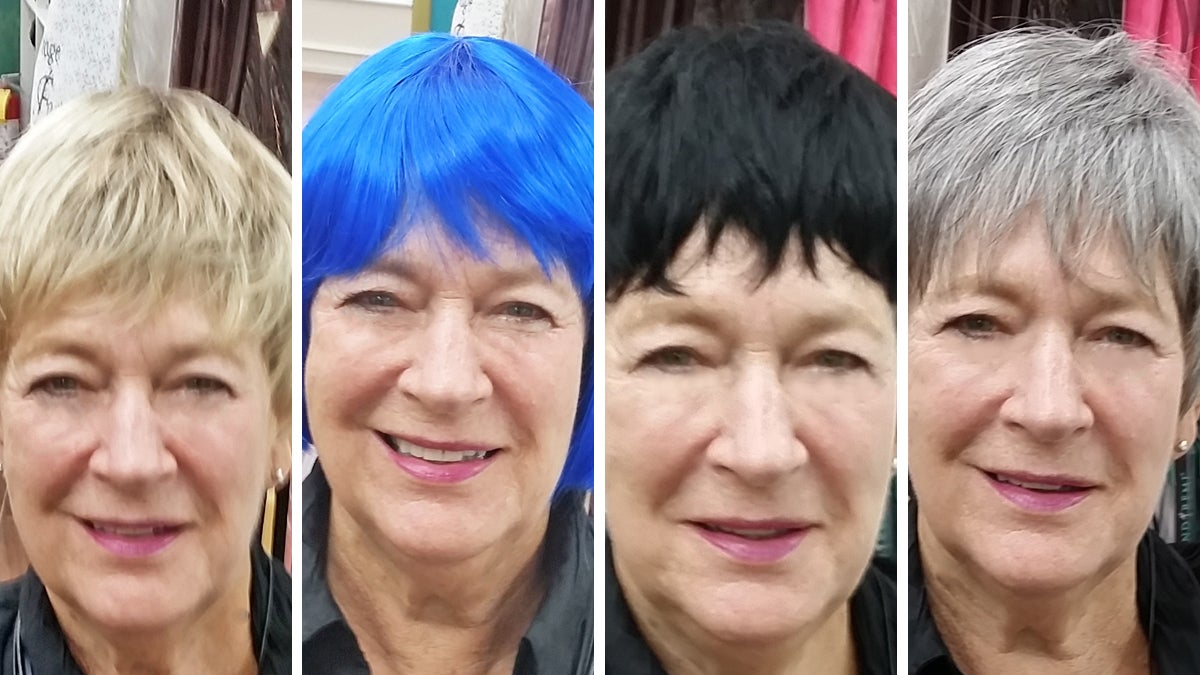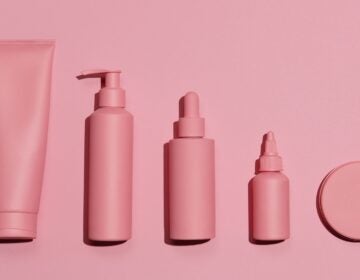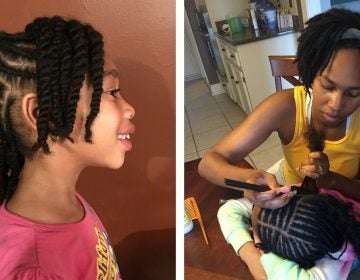Women who lose their hair, and the wigs that keep it private
About a third of women experience hair loss. After menopause, that fraction doubles, with thinning hair and bald spots stealing happiness, self-esteem, and quality of life.

The author is shown with various options at Lois Arnold's wig shop on S. 4th Street in Philadelphia. (Susan Perloff
Leah Wall, of Southwest Philadelphia, was 30 when she first noticed her hair loss. A dermatologist diagnosed lupus, an autoimmune disease that triggers the condition.
“Lupus is awful,” Wall says. “You look healthy, but inside it’s pain and gastrointestinal symptoms. But the hair loss is hardest to deal with.Even after 10 years, I still go through periods of depression and sadness about not having hair.”
Psychological impact
About a third of women experience hair loss (alopecia). After menopause, that fraction doubles, with thinning hair and bald spots stealing women’s happiness, self-esteem, and quality of life. Yes, men hate going bald, too, but society — and sometimes the individual — more readily accepts hairless pates on men.
Women with alopecia lose hair first on the tops of their heads. As each hair follicle gets smaller, the part widens and the hair thins. The front hairline stays the same. If not treated, hair loss in female-pattern baldness is permanent, and no one knows how to prevent it.
George Cotsarelis, MD, chair of dermatology at the University of Pennsylvania, gets specific. “Say a woman has very thick hair all her life,” he says. “Around her 40s or during menopause, she starts losing hair. She says that a rubber band that used to go around her ponytail once now has to wrap twice. When she has lost 20 percent of her hair, it feels like a huge loss, but her doctor says it’s not a medical problem.
“These women don’t typically end up wearing wigs, because that type of hair loss tends to plateau,” he says. Some use scalp makeup, change their style, buy hair transplants, or try hair-producing medications.
Arming women against hair loss
Lois Arnold was a hairdresser for decades. She owned a salon and taught other stylists. In 1988, her Aunt Veda underwent chemotherapy, and the doctors never mentioned that hair loss would follow. “When I shampooed her, all her hair came out,” Arnold says. “It was devastating to both of us. She had nothing to put on her head when she left, so I gave her a towel.
“The next day, we went to wig stores. People were rude and impatient, treating Veda like she had the plague. I bought her two wigs, but all the way home, she kept wiping her eyes. I remade the wigs for her. Since then, I have reinvented many women. I became the go-to woman for wigs in the black community,” she says, mostly at her salon in West Philadelphia.
Last year Arnold opened Hairs2U, a nonprofit wig bank and retail store on South 4th Street in Fabric Row. Since then she has sold about 300 blonde, brunette, and violet wigs. She has donated another 100 to uninsured and underinsured women and children going through illnesses that cause hair loss.
To raise awareness about the devastation of hair loss — and to fund the creation of more hairpieces for uninsured and underinsured women — Arnold is holding a Wig Walk on Oct. 1. She hopes a few hundred bald and hairy women and men — alopecia sufferers, chemo patients, and supporters — will hike from Rittenhouse Square to Hairs2U, enjoying snacks and a fashion show at the end. For $45, participants receive a fun-color wig.
Comfortable and beautiful
For 10 years, Jeanette Caligiuri operated the Faith and Hope Boutique in the Hospital of the University of Pennsylvania with her sister Bonnie, selling products, including wigs, for cancer survivors. The shop closed in July. “Women should feel comfortable and beautiful in their hair,” Caligiuri says, pointing out that some always hate their natural hair for being too curly, too straight, too something. “Some want a wig to make them look exactly as they did before, and some appreciate a change.
“We’re in a society that values looks and first impressions,” says Caligiuri, whose breast cancer at age 39 launched her crusade and career.
Some women with alopecia forego wigs and believe bald is beautiful. And people with full heads of hair often choose wigs for design, style, fun, theater, and drag.
Medical schools don’t teach physicians about treating the emotional aspects of hair loss. But after devoting a half-day a week for 20 years to the problem, Cotsarelis has learned how important hair loss is to women. “They spend time on their hair. Hair is part of their well-being, and losing hair feels like a sense of decay, makes them feel unattractive.” His colleagues deem his specialty frivolous. Patients don’t.
Joyce Herstein, of Center City, didn’t know her hair was falling out until six months ago, when her hair stylist pointed to clumps on the comb. A dermatologist confirmed age-related alopecia and recommended a course of Rogaine. It worked, but Herstein chucked the product. She cut off her tresses and donated them.
She had actually started wearing wigs decades ago for parties and travel. “I originally had black hair,” she says, but at my age, I look better in lighter colors. I have four wigs, all wavy, light brown with blond highlights.” Not long ago, an “elderly gentleman” approached her on the street and admired her hairdo. He asked if she did her own hair.
“‘I do,’ I told him. No need to go into anything else. He said, ‘It’s beautiful, and so are you.’ He made my day.'”
WHYY is your source for fact-based, in-depth journalism and information. As a nonprofit organization, we rely on financial support from readers like you. Please give today.



